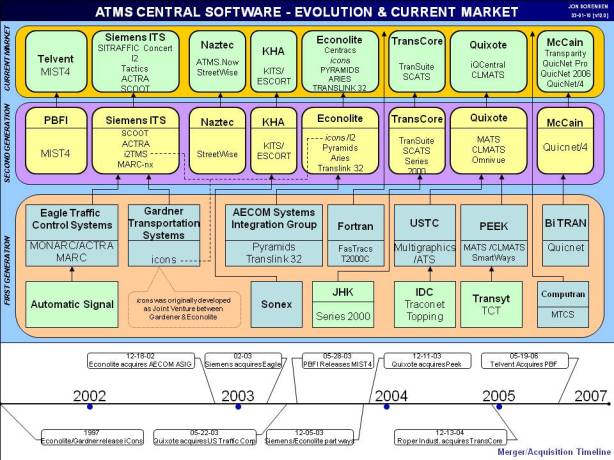It’s no secret that traffic signal systems are an essential component to the day-to-day operations of any urban transportation network. At the core of these systems is the central software, which typically provides centralized command and control functions, including management of communications between signalized intersections, as well as management of signal phasing, signal timing and signal coordination plans. These applications also often include command and control capabilities to operate and manage ITS technologies such as closed circuit television (CCTV) cameras, dynamic message signs (DMS), and vehicle detection systems. Due to the operational importance and magnitude of their direct interface with the traveling puiblic, central applications hold the greatest potential for improvement of operational efficiencies and optimization of existing transportation networks.
Applications currently available provide a wide range of features and options for traffic management agencies. Most of the current vendors have been in the business for 20 years or more, so their products are well seasoned. Current centralized applications do a nice job of providing basic command and control of typical traffic signal systems, provided the operating agencies are dedicated to maintaining the fiscal and physical resources required to operate and maintain these systems. However, during tough economic periods such as these, operating agencies have become increasingly short-staffed and must provide existing operational levels with extremely constrained budgets. In many instances, monitoring and management of central software is given up for responding to operations and maintenance issues in the field, thus increasing the need to further streamline and automate these applications.
One of the shortcomings of central signal system software is their ability to rapidly evolve. Unfortunately traffic signal system software has historically evolved at a glacial pace, sometimes requiring 10-15 years for significant feature upgrades. When newer transportation technologies emerge, it is essential that the central applications adapt in order to integrate the new technologies.
New technologies such as connected vehicles, smart phones and cloud computing will require significant modification to existing software platforms. With the pending onslaught of “connected devices” on its way, it will be necessary for the traffic signal applications to communicate with other transportation and infrastructure platforms. New operations models, including the Vehicle-to-Infrastructure (V2I) model, will exchange data and information between vehicles and traffic management systems, most notably Signal Phase and Timing (SPaT) data. Will “open data” and open-source platforms such as Linux or Android ever be able to make it into the central applications? Only time will tell.
The recent emergence of cloud-based architectures also holds potential value for traffic signal systems. Cloud-based central apps would provide an optimized tool for regional signal system operations, establish a centralized data warehouse open for third party development and lesson the infrastructure and staffing needs associated with operating and maintaining today’s central applications.




By far the biggest problem facing the (Intelligent) Traffic Signals system is the driver of the vehicle. Being humans they are by nature imperfect and subject to random behaviour and reactions that sometimes defy belief. Until such a time as all traffic is 100% automated there will never (in my opinion) be a fully successful solution to the ever-worsening congestion patterns that we are now experiencing. Sure we can deploy intelligence out into the field, make use of cloud-based applications, etc but the result will always be less than perfect.
As for connected vehicles – I’m not sure that I want to be one of the first to join/leave a “convoy”.
Open platforms and cloud computing could potentially reduce the cost, but by themselves don’t make the core algorithms operate better.
There’s a body of research going back at least 20 years that shows that having queue length information available as an input to signal control algorithms can provide dramatic improvements. While a large market penetration of connected vehicles could provide this information, video detection systems can, at least in theory, provide this data today. Yet the state of the practice has not advanced to using this approach. Why is this the case?
@Robin – I agree, the greatest potential for improvements to transportation system operations are social (human). i.e., telecommuting, game mechanics for altering travel times and/or modes of transportation, tax incentives for improving congestion and emmissions, driver education, etc.